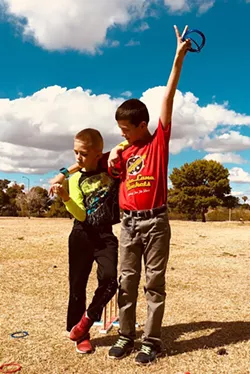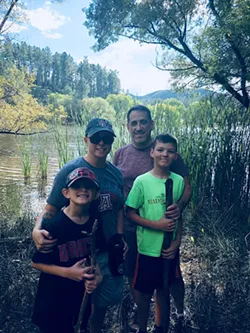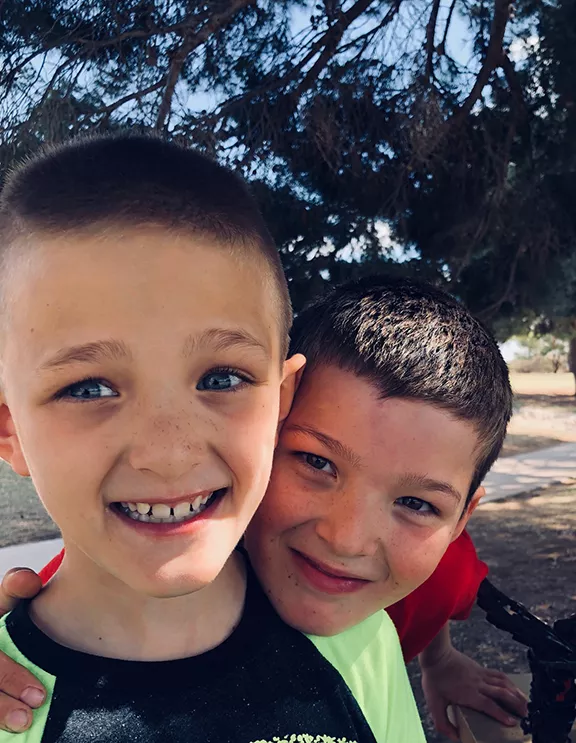Zeidman's son Tristan, whom he and husband Brian Hatfield adopted in 2017, turned 12 this year. Their rescue dog, Auggie, is a blind Staffordshire Terrier. These days, getting to know the parents of Tristan's school friends is more important than dinners out or trips to the theater, and they've replaced their condo with a home near a park where Tristan can ride his bike, in an area where they know all of their neighbors.
"We have the most traditional family you've ever met," Hatfield says with a laugh.
Hatfield and Zeidman met on a hookup app in 2013. They had each written off the idea of having a family—they were in their 40s, and same-sex marriage wasn't even legal in Arizona, yet. Zeidman's best friend had a child, and he was perfectly happy in his role as a doting uncle. When Hatfield came out to his family at age 30, there was sobbing, and yelling, and his parents mourning what a lonely, childless life he would have. A part of him internalized that.
"Never in my wildest dreams did I think that a one-night stand would turn into a relationship, marriage, starting a business and adopting a child," Hatfield says.
But suddenly, they were in love. And then, in a way that seemed almost as sudden for two people who thought it might never happen, same-sex marriage was legalized in Arizona, and they were husbands. Zeidman started a business and then sold it, so they found themselves with the financial means to build a life for themselves they wanted. It didn't take long to decide that an expensive house or car wasn't going to be where they found satisfaction. And there was something about watching Zeidman play the role of uncle so well that made Hatfield think he might do well as a father, too.
They got in touch with Project Jigsaw, an effort led by Equality Arizona and the Arizona Children's Association to provide equal opportunities in the foster care and adoption process to prospective parents, regardless of sexual orientation. Kevin and David Patterson, one of the first gay couples to be married in Arizona after the October 2014 ruling, played a large part in launching the organization. They'd started raising two adopted daughters together in 2013, but, because they weren't married, only one of them was allowed to be the legal adoptive parent. When they started looking into adoption, several agencies told them they wouldn't work with a same-sex couple.
By the time Hatfield and Zeidman started the process in 2016, the Pattersons knew the ropes pretty well, and directed them straight to the Arizona Children's Association.
"I think there's this notion that Arizona is a red state, so because of that, there's going to be all of this discrimination," Zeidman says. "I think that part of our story is to say that we were fully embraced."
The Changing Family
According to the Arizona Department of Child Safety's Semi Annual Child Welfare Report from March 2019, there were 13,782 children in out-of-home care (alternative accommodations for people under 18 unable to live with their parents, often due to abuse or neglect, and including foster care and group homes) as of December 31, 2018. A 2013 study by The Williams Institute, a think tank at UCLA Law, found that same-sex couples raising children are four times more likely than their different-sex counterparts to be raising an adopted child. They are six times more likely to be raising foster children.
"There are countless kids that don't have a home for whatever reason, and if a family steps up to go through the process and make an attempt to provide a home for this child, do you really want to disqualify them because they're gay?" says David Quist, a resource family specialist for the foster care program at Arizona Children's Association. "To me, that just seems a little bit draconian."
In 2017, the "What We Know" project, based at Cornell University's Center for the Study of Inequality, examined 79 scholarly studies from 1991 to 2017 about the well-being of children with gay or lesbian parents. The conclusion: "Taken together, this research forms an overwhelming scholarly consensus, based on over three decades of peer-reviewed research, that having a gay or lesbian parent does not harm children."
The winds are shifting on public opinion as well. A 2014 study by the Public Religion Research Institute, a nonprofit, nonpartisan organization which conducts independent research at the intersection of religion, culture and public policy, found that 68 pecent of Americans believe same-sex couples "can be as good as heterosexual couples in parents," up from 54 percent in 2003.
Quist says there are myriad factors Arizona Children's Association takes into consideration when they license foster parents, or when choosing where to place a child. The sexuality of the foster parent is rarely one of them. (It is "rarely" and not "never" because, for example, children identifying or coming out as LGBTQ+ might indicate a preference for a home where they know they'll be welcomed.)
In fact, same-sex parents can be a valuable source of support for foster children who identify as LGBTQ+, or who are struggling to fit in. One question caseworkers ask potential foster parents is whether they've experienced things like the loss of a family member, or being bullied in school. Those who have may be better able to empathize with a child going through a similar problem.
"They might relate to some of those experiences that a straight couple's not going to have had," Quist says.
Finding Tristan
Hatfield and Zeidman started by filling out a form about what kind of child they wanted. Neither of them had sisters, and their mothers had died young, so they felt they'd be better parents to a boy. They were in their 40s, so they didn't want an infant. They were open to any race, but indicated they didn't want to adopt a child with special needs.
In the meantime, they volunteered to help with outings for children living in group homes through Foster Arizona, a nonprofit dedicated to positively impacting the lives of children in foster care. By chance, they were placed with a group home full of children who were all on the autism spectrum. The experience showed them what a wide range of kids could share the diagnosis—including many who were so high-functioning they seemed almost neurotypical. So when their case worker told them she thought she'd found a perfect candidate for them, a 9-year-old boy named Tristan who was bright-eyed, curious and on the autism spectrum, they were open.
They went through his file. It was a thick one: Tristan had lived in four states with his biological parents, and there were records of Child Protective Services incidents in each of them. At age 5, he was moved into a group home, then into two different foster homes. Somewhere along the way, he'd been legally separated from his younger biological brother.
But what was it they say about a parent's love for a child? That it opens up new parts of your heart? That it makes you understand the meaning of the word "unconditional?" In "How to Stop Time," Matt Haig writes this about how the instant love a character felt for his daughter was both what everyone said would happen and yet was impossible to prepare for: "The way it is suddenly there, total and complete, as sudden as grief, but in reverse, is one of the wonders about being human."
Nothing a thick file could ever stand a chance against, anyway. Both Hatfield and Zeidman tear up when they recall the first time they met their son.
"We went to meet him at a park, and we had a picnic and we were kicking a ball around," Hatfield says. "Honestly, I had some reservations. And Steve looked up at me, and his eyes were flooded with tears, and he looked at me and he said, 'I love him already.' And that was it."
It really was it. Within 20 minutes, Tristan was asking if they could call them both "Dad." They spent Friday, Saturday and Sunday together. The next weekend, he stayed with them at their house. The weekend after that, he moved in.
Today, Tristan is an active, intuitive, affectionate kid. He's obsessed with police officers, and loves to shake the hand of every cop he meets to thank them for their service. The family of three calls themselves "Team Solid." They're still volunteers at Foster Arizona, and Hatfield is a committee member at the Arizona Children's Association.
Finding Jayden
One of Beverly Wohlert's friends likes to describe her as "a badass, lesbian, PhD, CEO." The PhD is in rehab counseling. She's the CEO of the National Council on Alcoholism and Drug Dependence, an organization which provides treatment and resources—ranging from intervention to long-term housing and support programs—for women experiencing drug or alcohol addiction. The "badass" descriptor, obvious right away when you see her mohawk, only feels more appropriate the more you learn about her.
Wohlert came out as a lesbian in her mid-20s, after she'd been married to a man. She didn't think she was interested in having children, but she spent a lot of her time at work around kids, and after a while, holding all those babies made her start to reconsider.
"Then I went through a crazy year—my dad died, my grandma died, my stepdad died," she says. "I just thought 'Life is too short to not have kids,' so I decided I was going to have a baby no matter what."
Wohlert had her biological son, Liam, in 2008 while she was with a female partner. When Liam was 8 years old, after seeing such a need in the community, Wohlert and her partner began looking into the possibility of adopting another child. They knew older kids were less likely to be adopted, and they wanted someone close in age to Liam to make things like family vacations and trips to Disneyland simple. Wohlert saw Jayden, a blonde-haired, blue-eyed 8-year-old with a vibrant smile, on the news, as a part of 12 News' "Wednesday's Child" segment, which features children in the Arizona foster care system.
"There was something in his video that kept speaking to me," she says.
After much back and forth in her attempts to meet Jayden, she got ahold of his file. She found out about an array of behavioral issues, a history of multiple foster parents and group homes, and an older, biological brother, from whom Jayden was legally separated. Also in the file was an email address from the brother's adoptive family, inviting whoever adopted Jayden to reach out if they were interested in reuniting the brothers.
Acclimating to Jayden's outbursts, and his diagnoses, including attention deficit disorder, post-traumatic stress disorder and emotional dysregulation disorder, was difficult. In the process of fostering him, Wohlert and her partner, Liam's adoptive mother, split up. But after a few months of living with Jayden, Wohlert decided she wanted to adopt him, and reached out to the email address in the file. Hatfield and Zeidman, the adoptive parents of Jayden's biological brother, Tristan, said they were looking forward to meeting her.

Tristan and Jayden Find Each Other
"Of course, we were thrilled to find out that she was a lesbian," says Hatfield, the very friend who now describes Wohlert as a badass, lesbian, PhD CEO.
Any worries that Jayden's new family might not be comfortable with Tristan having two dads were effectively banished. After a few months of emailing and meetings between the adults, as well as establishing some ground rules to keep the boys' best interests at heart, Jayden's adoption was finalized and the families set up a time to reunite the brothers. They met at a park, and Tristan and Jayden broke into a sprint the moment they saw one another.
"They hadn't seen each other in over a year, and they just ran up to each other and started hugging each other. They flew a kite and started kicking a soccer ball around," says Hatfield. "Reuniting the brothers is one of the greatest accomplishments of my life."
These days, the families see each other several times a month. They celebrate birthdays and holidays together and often swap babysitting or sleepover duties. Earlier this month, they went to something called "Messy Fest," an action-packed day full of attractions like a mud tug of war, a color run and an ice cream slide.
Their lives, too, can be messy. Growth for both boys is a process, but it's one all parents are committed to. Wohlert is working with Jayden, now 11, on his reading and on reducing aggressive behaviors, and is proud of the progress he's made. Hatfield and Zeidman have Tristan in a special-needs school they think is perfect for him—at a recent PTA meeting, three separate parents told Hatfield that their children had described Tristan as their best friend. Both boys love to dress up and cosplay. Hatfield says outings where Tristan is decked out in an in astronaut or Ghostbuster costume are not uncommon. Wohlert, Jayden and Liam like going to Comic-Con and are devoted to their taekwondo practice.
"I think that it's been kind of cool to watch that transition of our society, where being gay doesn't have to decide what type of family structure you would have," Zeidman says. "That's something that, when we first came out, it just didn't exist—or, it did exist, probably, but it was so invisible that you would simply never see that."
Now they're not only seeing these new examples of what a family can be, but they're living one. Hatfield says people who hear their story often exclaim, "Oh my God, you're like a sitcom!" Maybe sometimes life does imitate art. And Wohlert says through all the messiness and meltdowns, through the perils and pitfalls, and through the triumphs and treasured moments of parenthood, the way their families came together somehow seems just right.
"It's kind of cool that even though we're both gay families, that both kids can still have either role model," Wohlert says. "I know some people feel like there needs to be a female figure and a male figure, but I guess the point is that can happen despite the makeup of the family, right? I think it's just important to note that you can have everybody and everything despite what the immediate parental makeup is."




